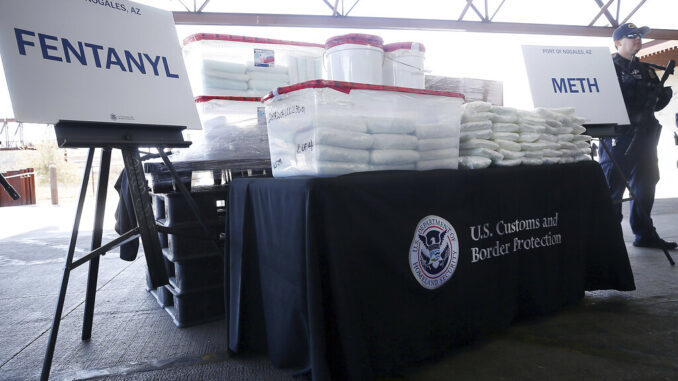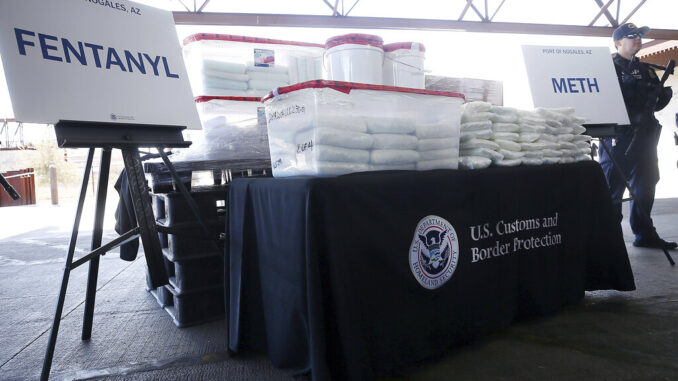

As the addiction and overdose crisis that has gripped the U.S. for two decades turns even deadlier, state governments are scrambling for ways to stem the destruction wrought by fentanyl and other synthetic opioids.
In statehouses across the country, lawmakers have been considering and adopting laws on two fronts: reducing the risk to users and increasing the penalties for dealing fentanyl or mixing it with other drugs. Meanwhile, Republican state attorneys general are calling for more federal action, while some GOP governors are deploying National Guard units with a mission that includes stopping the flow of fentanyl from Mexico.
“It’s a fine line to help people and try to get people clean, and at the same time incarcerate and get the drug dealers off the streets,” said Nathan Manning, a Republican state senator in Ohio who is sponsoring legislation to make it clear that materials used to test drugs for fentanyl are legal.
The urgency is heightened because of the deepening impact of the drugs. Last year, the U.S. Centers for Disease Control and Prevention reported the nation had hit a grim milestone. For the first time, more than 100,000 Americans had died of drug overdoses over a 12-month period. About two-thirds of the deaths were linked to fentanyl and other synthetic drugs, which can be 50 to 100 times more potent than morphine, heroin or prescription opioids.
The recent case of five West Point cadets who overdosed on fentanyl-laced cocaine during spring break in Florida put the dangers and pervasiveness of the fentanyl crisis back in the spotlight.
The chemical precursors to the drugs are being shipped largely from China to Mexico, where much of the illicit fentanyl supply is produced in labs before being smuggled into the U.S.
While users sometimes seek out fentanyl specifically, it and other synthetics with similar properties are often mixed with other drugs or formed into counterfeit pills so users often don’t know they’re taking it.
Advocates say test strips can help prevent accidental overdoses of drugs laced with fentanyl. The strips are given out at needle exchanges and sometimes at concerts or other events where drugs are expected to be sold or used.
Thomas Stuber, chief legislative officer at The LCADA Way, a drug treatment organization in Ohio that serves Lorain County and nearby areas, has been pushing for the test strip legislation. It also would ease access to naloxone, a drug that can be used to revive people when they’re having opioid overdoses.
“This is a harm-reduction approach that has received a lot of acceptance,” he said. “We cannot treat somebody if they’re dead.”
The National Conference of State Legislatures found 12 states with fentanyl-specific drug trafficking or possession laws as of last year. Similar measures have been introduced or considered since the start of 2021 in at least 19 states, the Associated Press found in an analysis of bills compiled by LegiScan. That does not include measures to add more synthetic opioids to controlled substance lists to mirror federal law; those have been adopted in many states, with bipartisan support.
Fentanyl has been in the spotlight in Colorado since February, when five people were found dead in a suburban Denver apartment from overdoses of fentanyl mixed with cocaine.
Under state law, possession with intent to distribute less than 14 grams of fentanyl is an offense normally punishable by two to four years in prison. But fentanyl is so potent that 14 grams can represent up to 700 lethal doses, under a calculation used by the U.S. Drug Enforcement Agency.
“It’s making it impossible to hold the dealer accountable for the deadliness of the drugs they’re peddling,” Colorado House Speaker Alec Garnett, a Democrat, said in an interview.
Democratic governors are focusing primarily on harm reduction methods. Among them is Illinois Gov. Jay Pritzker, who released a broad overdose action plan last month.
Several Republican governors and attorneys general have responded to the rising death toll with administrative enforcement efforts and by pushing for more federal intervention.
Last year, Texas Gov. Greg Abbott and Arizona Gov. Doug Ducey called for states to help secure the border with Mexico. Along with trying to keep people from entering the U.S., stopping the flow of fentanyl was cited as a reason. Several other Republican governors have sent contingents of state troopers or National Guard units.
The Texas Military Department said that from March 2021 through earlier this month, its troops near the border confiscated more than 1,200 pounds of fentanyl. By comparison, federal authorities reported confiscating about 11,000 pounds in 2021 — still a fraction of what entered the country.



